Related Research Articles
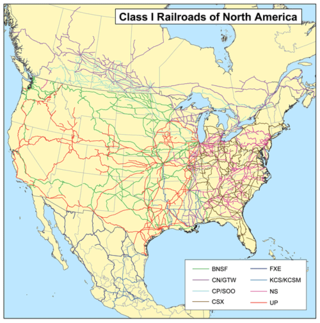
Railroad classes are the system by which freight railroads are designated in the United States. Railroads are assigned to Class I, II or III according to annual revenue criteria originally set by the Surface Transportation Board in 1992. With annual adjustments for inflation, the 2019 thresholds were US$504,803,294 for Class I carriers and US$40,384,263 for Class II carriers.

The Association of American Railroads (AAR) is an industry trade group representing primarily the major freight railroads of North America. Amtrak and some regional commuter railroads are also members. Smaller freight railroads are typically represented by the American Short Line and Regional Railroad Association (ASLRRA), although some smaller railroads and railroad holding companies are also members of the AAR. The AAR also has two associate programs, and most associates are suppliers to the railroad industry.
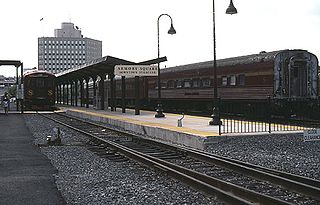
OnTrack was a suburban rail line that operated in Syracuse, New York, from 1994 to 2008. The line ran from the Carousel Center on the city's north side via Armory Square and Syracuse University to Colvin Street, with summer weekend service south to Jamesville, mainly using 1950s-era diesel railcars.

The SEPTA Regional Rail system is a commuter rail network owned by SEPTA and serving the Philadelphia metropolitan area. The system has 13 branches and more than 150 active stations in Philadelphia, Pennsylvania, its suburbs and satellite towns and cities. It is the sixth-busiest commuter railroad in the United States, and the busiest outside of the New York, Chicago, and Boston metropolitan areas. In 2016, the Regional Rail system had an average of 132,000 daily riders and 118,800 daily riders as of 2019.

The Iowa Interstate Railroad is a Class II regional railroad operating in the central United States. The railroad is owned by Railroad Development Corporation of Pittsburgh, Pennsylvania.
Railroader of the Year is an annual award presented to a North American railroad industry worker by trade journal Railway Age. The award was first presented in 1964 by trade journal Modern Railroads and has continued through the magazine acquisition in 1992 to the present.

Railway Age is an American trade magazine for the rail transport industry. It was founded in 1856 in Chicago and is published monthly by Simmons-Boardman Publishing Corporation.

The Kiamichi Railroad Company is a Class III short-line railroad headquartered in Hugo, Oklahoma.

A train driver is a person who operates a train, railcar, or other rail transport vehicle. The driver is in charge of and is responsible for the mechanical operation of the train, train speed, and all of the train handling. Train drivers must follow certain guidelines for driving a train safely.
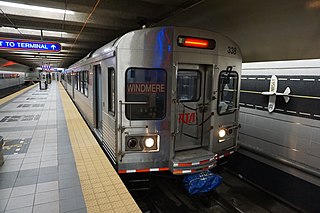
The Red Line is a rapid transit line of the RTA Rapid Transit system in Cleveland, Ohio, running from Cleveland Hopkins International Airport northeast to Tower City in downtown Cleveland, then east and northeast to Windermere. 2.6 miles (4.2 km) of track, including two stations, are shared with the light rail Blue and Green Lines; the stations have high platforms for the Red Line and low platforms for the Blue and Green Lines. The whole Red Line is built next to former freight railroads. It follows former intercity passenger rail as well, using the pre-1930 right-of-way of the New York Central from Brookpark to West 117th, the Nickel Plate from West 98th to West 65th, and the post-1930 NYC right-of-way from West 25th to Windermere. The Red Line uses overhead lines and pantographs to draw power and trains operate using one-person operation. In 2022, the line had a ridership of 2,808,200, or about 9,700 per weekday as of the third quarter of 2023.

The Maryland and Delaware Railroad Company is a Class III short-line railroad, formed in 1977 to operate several branch lines of the former Penn Central Railroad in both Maryland and Delaware, United States. These branches were omitted from the system plan for Conrail in 1976 and would have been discontinued without state subsidies. As an alternative to the higher cost of subsidizing Conrail as the operator of the branch lines, the Maryland and Delaware governments selected the Maryland and Delaware Railroad Company (MDDE) to serve as the designated operator.
Lowell S. "Jake" Jacobson (1940-2021) served 29 years with the Union Pacific Railroad, later President and Chief Operating Officer of the Copper Basin Railway of Hayden, Arizona.

The Terminal Railroad Association of St. Louis is a Class III switching and terminal railroad that handles traffic in the St. Louis, Missouri, metropolitan area. It is co-owned by five of the six Class I railroads that reach the city.

The Nittany and Bald Eagle Railroad is a short line railroad that operates 73 miles (117 km) of track in Blair, Centre, and Clinton counties in Pennsylvania in the United States. It is part of the North Shore Railroad System.
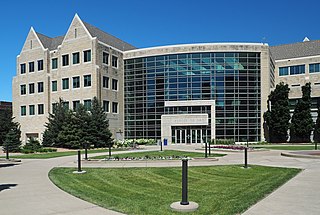
The University of St. Thomas School of Law is the law school of University of St. Thomas in Minneapolis, Minnesota. It is one of three law schools in Minneapolis–Saint Paul. It currently enrolls 434 students. St. Thomas Law is accredited by the American Bar Association. It is also a member of The Association of American Law Schools. Founded in 1999, the School of Law graduated its first class in 2004.
The Jake Award is an annual award presented to North American short line railroads by rail transport industry group American Short Line and Regional Railroad Association. The award recognizes railroads with a frequency-severity index (FSI) rating of 0.00, thus having no FRA reportable injuries.
In the United States, a regional railroad is a railroad company that is not Class I, but still has a substantial amount of traffic or trackage. The Association of American Railroads (AAR) has defined the lower bound as 350 miles (560 km) of track or $40 million in annual operating revenue.
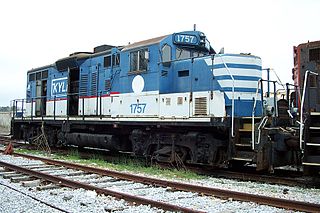
A shortline railroad is a small or mid-sized railroad company that operates over a relatively short distance relative to larger, national railroad networks. The term is used primarily in the United States and Canada. In the former, railroads are categorized by operating revenue, and most shortline railroads fall into the Class III or Class II categorization defined by the Surface Transportation Board.
The Railroad Track Maintenance Tax Credit, also known as the 45G Tax Credit, is a federal income tax credit for track maintenance conducted by short lines and regional railroads in the United States. The credit granted an amount equal to 50 percent of qualified track maintenance expenditures and other qualifying railroad infrastructure projects. It was inserted into the tax code by the American Jobs Creation Act of 2004, and was taken into effect on January 1, 2005 with an expiration date of December 31, 2009. Following the Tax Relief, Unemployment Insurance Reauthorization, and Job Creation Act of 2010, signed into law on December 17, 2010, the tax credit was retroactively extended for 2010 and the expiration date moved to January 1, 2012. United States fiscal cliff legislation retroactively reinstated the tax credit for 2012 when signed into law January 2, 2013. The tax credit is effective through December 31, 2022.
The National Railroad Construction and Maintenance Association, Inc. (NRC) is a trade association in the railroad and rail transit construction industry. The NRC is a non-profit trade association, governed by a board of directors and administered by the Washington, D.C., government relations firm, TGA AMS. NRC members include rail construction and maintenance contractors such as Balfour Beatty Rail, Inc.,Colo Railroad Builders, Delta Railroad Construction, Inc., Herzog Contracting Corp., Kiewit Western Co., Loram Maintenance of Way, Inc., RailWorks Corporation, and Stacy and Witbeck, Inc.; in addition to supplier companies such as A&K Railroad Materials, Inc., Harsco Rail, L. B. Foster Company, Progress Rail Services, Inc., and Western-Cullen-Hayes, Inc.
References
- ↑ Advanced Solutions International Inc. "Compliance Assessments". www.aslrra.org. Archived from the original on 2017-06-14. Retrieved 2017-06-07.